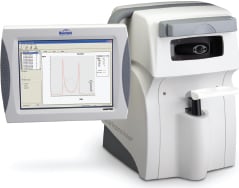Spotlight ON TECHNOLOGY & TECHNIQUE
ORA Offers Multiple Clinical Applications
By Robert Murphy, Contributing Editor
Reichert's 2005 introduction of a non-contact tonometer called the Ocular Response Analyzer (ORA) ushered in a new way to apply corneal biomechanics to obtain IOP readings said to be more accurate than those of the Goldmann applanation method, while offering refractive surgeons a means of gauging the cornea's structural integrity in LASIK candidates and those with corneal ectatic conditions such as keratoconus and Fuchs' endothelial dystrophy.
Now, a new “all-in-one” version of the ORA arrives on the scene with a built-in computer to save footprint space as well as numerous new features — left/right mounting, 180-degree rotating, a tilt screen and an intuitive touch-screen interface — designed to make it easier to use.
How it Works
The ORA works by firing an air puff to displace the cornea and then emits an infrared beam to measure that displacement. The infrared beam then forms a wavefront from which corneal biomechanical properties can be analyzed.
Along the way, Reichert scientists used the device to measure the cornea's viscoelasticity, which they termed “corneal hysteresis” and which takes into account corneal resistance in IOP measurements. Basically, the greater the central corneal thickness, the higher the apparent Goldmann IOP reading. “Once the cornea is altered from its original thickness, whether due to ocular pathology or surgery, then the standard measurements — including Goldmann — become inaccurate,” says George Waring, MD, director of refractive surgery at Charleston's Storm Eye Institute.
The ORA's data on ocular biomechanics extends to something called the corneal resistance factor, a measure of a cornea's stiffness or softness that is particularly useful in diagnosing and managing keratoconus. A mathematical formula calculates the corneal resistance factor as the difference between the force necessary to flatten the cornea as the air pressure rises and the force at which the cornea regains its normal shape with falling air pressure, with the latter figure multiplied by a constant. Remember, too, that a cornea's elasticity can be affected by short-term factors such as corneal edema.

Measurement of corneal stiffness can allow clinicians to better understand the biomechanics that affect intraocular pressure.
How it Helps
Besides its applicability to glaucoma management, refractive surgeons find it invaluable in screening viable candidates for LASIK and other procedures while ruling out the structurally unqualified. “It's really the only device that measures directly what we're looking for, which is, how biomechanically sound are these structures?” Dr. Waring says. “Are they sound enough to undergo an elective surgical procedure?”
Post-LASIK changes in corneal biomechanics are thought to be due to the flap creation, which alters the anterior stromal lamellar configuration. The ORA is likewise useful in identifying a steroid-induced IOP spike in postsurgical eyes with altered corneas.
Just as important is the ORA's utility in dealing with patients with keratoconus, Fuchs' endothelial dystrophy and pediatric congenital glaucoma, especially in those with marked striae and large corneal diameters. The ORA's waveform analysis allows the user to compare a patient's corneal biomechanics to an age-based population with varying degrees of normal and ectatic corneas.
And then there's diabetes, which is said to cause stromal structural changes owing to collagen crosslinking, which in turn is believed to stiffen the cornea. In these patients, Goldmann applanation tonometry overestimates the true IOP. Out-comes from the Ocular Hyper tension Treatment Study suggest that diabetes may forestall the progression to primary open-angle glaucoma.
Longtime ORA user Mitsugu Shimmyo, MD, of New York City, who has been working with the device since its early clinical trials, finds that he “cannot do without it. As a clinician in a busy practice, I use ORA measurements on every patient at every visit as a part of my necessary eye exam,” Dr. Shimmyo says. “The ORA gives me confidence in measuring more accurate IOP than Goldmann applanation tonometry, giving me baseline readings and changes in corneal status. The ORA results are fed into my electronic medical records online for quick viewing, storage, and consecutive comparison.” OM
For more information, visit www.reichert.com.








